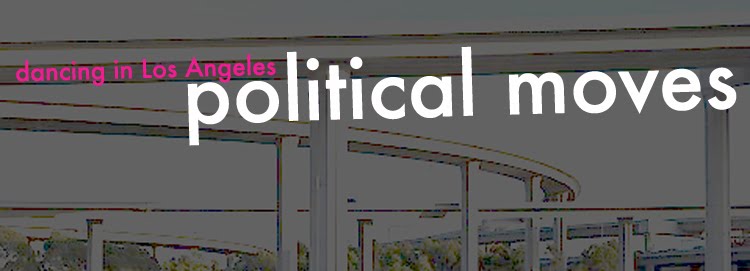 Photo: Ashley Hunt
Photo: Ashley HuntSurveillance Solos by Rebecca Alson-Milkman
Highways Performance Space, Santa Monica, CA
Feb 15-16. 2010
By: Joel Smith 1/15/10
Richly gestural, delicately nuanced, subtly subversive - Surveillance Solos provokes questions about privacy, government control, and human contact.
Rebecca Alson-Milkman began the process of making Surveillance Solos in 2007 in response to her frustration with continued surveying of suspected foreign and domestic (terrorists), with little or no ground, by the US government. Wiretapping, web monitoring and record pulling continues as citizens are denied their civil rights. Alson-Milkman protests to remain vigilant, vocalizing her rights amidst a new era of Obama Change that has yet to make good on its promises. With little to no movement in recouping some of these privacy rights, new questions are provoked about what our privacy means to us. Do these questions hold any weight given our contemporary involvement in social networking sites, such as Facebook, Twitter and MySpace, where we brand all of our own personal data onto the super-web for almost anyone to see?
Inspired by these questions, Alson-Milkman worked individually with Carol McDowell, Ally Voye, Christine Suarez and Taisha Paggett to construct solo movement studies based on each dancer’s own connection to notions of surveillance. Documenting text from conversations and notes taken by the dancers, a score/script/dialogue was woven together in order to create an evening-length piece. At just under fifty minutes, ‘Solos’ illuminates intimate details of each dancer to metaphorically express the importance of one’s privacy. Each solo, different in movement vocabulary, use of text, video projection and props, reveals ‘real’ details about each dancer, including the use of their real names, in order to doubly connect to the question, “what is private and what is public, and ultimately, what is real.”
Central to the piece is Alson-Milkman’s role as ‘agent bureaucrat,’ reading various documents on stage as a narrator would. Speaking in a monotone telephone operator voice, different kinds of texts are read to accompany the dancing: words that describe the dancing, words that illuminate the dancer’s ‘real-life’ predicaments, words that are read verbatim from government documents, and words that reveal the choreographer’s (Alson-Milkman) neurosis of making the dance. The documents read appear as a large projection on the back wall to create a double effect, both to overemphasize the language used, as well as to inscribe the text into the performance as a scenic device.
The documents range from direct quotes from the Patriot Act to Facebook profile pages, traffic violations to the mundane activities of a woman’s morning routine. For example, in Carol McDowell’s solo, the text read by Alson-Milkman is of McDowell’s personal Facebook profile. Notions of a strong, independent woman looking for companionship are read as McDowell subtly references the text through mimetic gesturing: flexing biceps, surfing and Yoga practice. Intermittent references to body positioning in her photos reflect specific movements that she executes on stage, including “bent knees” into a standing balance on one leg, with free toe pointed and arms stretched wide…something similar to flying, hovering or scaling with an acrobatic feel. She continues with gestures that reference falling, gathering clouds and wallowing in the wind. Lovely, by the way.
Ally Voye’s solo involves exaggerated gesturing of a California girl driving a car, putting on make-up, checking herself in the mirror and oblivious to traffic laws. The most playful of them all, Voye’s solo dissolves into a feeling of isolation, trapped by the laws that govern the streets. She spends half of her solo on the floor, sideways with little momentum to move. Standing and effortlessly falling, Voye’s persistence of getting back up, flanked by moments of suspension before falling again, creates an emotional impact.
Layers of meaning are added as Christine Suarez flitters quickly about the stage while a man reports the “mundane actions of her morning routine.” Acting both as agent and ex-husband, Justin Zsebe positions himself in the center of her world. While gesturing the actions of cleaning house, getting ready in the bathroom and cooking breakfast, Suarez is performing an unspecified, triple-meter folk-like dance. This kind of parallel processing makes for a delicious performance.
The dance continues with intermittent disruptions of solos that turn into duets that turn into trios. Taisha Paggett performs at a desk and with a chair, frantically, yet precisely and quite successfully, gesturing the actions of an office person having to deal with an angry public. She is frontal and direct, and at one point mimes being finger printed. A projection of documents flips vigorously on the back wall, occasionally stopping to reveal such words as confidential and UK Border Agency. She sits, patiently watching the documents pass.
The work concludes with Alson-Milkman dancing her own solo as Zsebe speaks directly to the audience about the agent’s life, aka Rebecca. From the experiences of living in Los Angeles, to taking yoga classes, to having rehearsals and meetings with each of the dancers, we begin to see her accumulate most of the information (dancing) of the other dancers. Wallowing in the wind while doing a triple-step folk pattern, striking familiar poses to losing balance, Surveillance Solos becomes incredibly self-reflective, as the choreographer and her process is finally staged. We see the vulnerability of her experience making this work and sharing it with us. Poetically, the work ends with Alson-Milkman evaporating in, and finally out of, our consciousness.
The work is patient, specific to its goals and performed beautifully by some of LA’s most revered dancers.
The Surveillance Solos opens Friday, January 15, 2010 at Highways Performance Space in Santa Monica and runs through Saturday, January 16th..
You can find more specific information about Alson-Milkman’s process of making Surveillance Solos on her website. Click on ‘Current Work’ to read about the specific solos as well as her inspiration for making the work.
Dates: Friday and Saturday, January 15-16, 2010
Location: Highways Performance Space, 18th St. Arts Complex, 1651 18th St. Santa Monica, CA 90404
Tickets: https://ww03.elbowspace.com/servlets/cfd?xr4=&formts=2006-05-23%2012:16:21.515002
Alson-Milkman Dance: http://alsonmilkmandance.com
